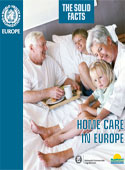Home care in Europe. The solid facts

Download
Edited by Rosanna Tarricone and Agis D. Tsouros
2008, viii + 36 pages
ISBN 978 92 890 4281 9
This publication is only available online.
Demographic, epidemiological, social, and cultural trends in European countries are changing the traditional patterns of care. The next decades will see rising numbers of care-dependent older people and noncommunicable diseases as the leading cause of chronic illness and disability. Further, urbanization and the break-up of the traditional large family group will lead to gaps in the care of older or disabled family members. These changes in needs and social structure require a different approach to policy and services in the health and social sectors; a disease-oriented approach alone is no longer appropriate.
Home care could be an answer to these issues: a sustainable approach to prevent the need for unnecessary acute or long-term institutionalization and to maintain people in their homes and communities as long as possible. Along with new forms of service delivery organization, technological innovation can represent a viable solution to developing home care in Europe, provided that health care systems can further enhance integration and coordination.
This publication is part of the work of the WHO Regional Office for Europe to present evidence for health policy- and decision-makers in a clear and understandable form. It explains why health and social services should provide high-quality and targeted home care for disabled and older people. It provides evidence for the effectiveness of home care, shows how it can be improved and explains the need to ensure equitable access. The publication also explores the varied cultural and care contexts in different countries and reveals how to educate professionals and the public about these issues. This booklet seeks to broaden awareness, stimulate debate and promote action.



